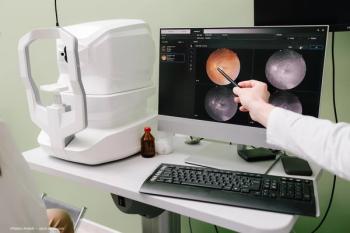
Using opioids to prevent sneezing and potential ocular tissue damage during sedation and periocular injections
Key Takeaways
- Propofol sedation can trigger sneezing during periocular injections, risking needle injury to the globe or optic nerve.
- Opioids such as fentanyl or alfentanil effectively suppress the sneeze reflex, reducing the risk of injury.
Opioids like fentanyl effectively prevent sneezing during propofol sedation for periocular injections, enhancing patient safety in ophthalmic procedures.
When propofol is used to sedate patients and during periocular injection, the stage may be set for a sneeze reflex, an unexpected movement that can cause needle injury to the globe or optic nerve or a hematoma. To circumvent this risk, Jeremiah Tao, MD, advises using the opioids, fentanyl or alfentanil, to suppress that reflex.1
Tao discussed this research during his presentation at the Egyptian Ophthalmological Society (EOS) meeting held from May 7-9, 2025.
He is from the Department of Ophthalmology, University of California, Irvine, CA, and was joined in this study by investigators from Oculofacial Plastic and Orbital Surgery LLC, Anesthesia Consultants of Indianapolis, and the Department of Ophthalmology, Indiana University, all in Indianapolis.
The investigators explained the connection of the drugs with the sneeze reflex. “Periocular local anesthesia has been shown to activate the sternutatory reflex, which may manifest as sneezing.2,3 Stimulation of the ophthalmic (VI) or maxillary divisions (VII) of the trigeminal nerve presumably activate the afferent pathway. Fibers extend to the trigeminal nucleus and reticular formation and are then relayed to the pons and medulla. Efferent fibers are sent to facial nerves, spinal nerves, and the diaphragm. The photic sneeze reflex, which may have an autosomal dominant inheritance pattern, may share a similar pathway.4,5
Unexpected or sudden sneezing during injection, they said further, can be a dangerous side effect in periocular injection, in which abrupt head movement may cause globe injury, globe penetration, or vascular injury with subsequent hematoma. The optic nerve may be similarly at risk during retrobulbar injections.
In the study under discussion, the researchers investigated the efficacy of concomitant fentanyl or alfentanil in reducing sneezing following propofol and during periocular injections.
Prospective, randomized study
A total of 81 adult patients were included who were undergoing conscious sedation before periocular injection of local anesthesia. In this study, patients received propofol and then were randomized as follows: propofol only (25 patients); propofol plus midazolam, a benzodiazepine (14 patients); propofol plus an opioid (31 patients); and propofol plus midazolam and an opioid (11 patients). The occurrence of sneezing was the main outcome measure. Patients also were assessed for cardiorespiratory parameters, analgesia, and adverse side effects of sedatives.
Tao and colleagues reported, “Of the patients who received no opioid, 17 of 39 (43.6%) patients sneezed. Of the patients who received an opioid, none of 42 patients sneezed (p = 0.0001 by Fisher exact two-tailed test). Among subjects receiving no opioids, midazolam was associated with a higher incidence of the sneeze reflex, but this was not quite statistically significant (p = 0.09). No adverse cardiorespiratory events were noted and analgesia was universally adequate.”
Based on the data, the investigators concluded that the opioids, fentanyl or alfentanil, eliminated the sneezing associated with propofol sedation and eyelid local anesthesia injection in a relatively healthy patient population undergoing periocular surgery in an ambulatory care setting. Tao and colleagues advised that further investigation is warranted of the various parameters that aggravate and alleviate sneezing during conscious sedation and injections to the periocular tissues.
“Nevertheless, the concomitant use of fentanyl or alfentanil with propofol should be considered, when appropriate, to make surgery both comfortable and safe for patients undergoing ophthalmic or facial procedures after propofol hypnosis and when a needle is placed near vital structures,” they commented.
References
Tao J, Nunery W, Kresovsky S, Lister L, Mote T. Efficacy of fentanyl or alfentanil in suppressing reflex sneezing after propofol sedation and periocular injection. Ophthal Plast Reconstr Surg. 2008;24:465-7.
Abramson DC. Sudden unexpected sneezing during the insertion of peribulbar block under propofol sedation. Can J Anesthesia. 1995;42:740–3.
Wessels IF, Wessels DA, Zimmerman GJ. The photic sneeze reflex and ocular anesthesia. Ophthalmic Surg Lasers. 1999;30:208–11.
Forrester JM. Sneezing on exposure to bright light as an inherited response. Hum Hered. 1985;35:113–4.
Peroutka SJ, Peroutka LA. Autosomal dominant transmission of the “photic sneeze reflex.” N Engl J Med. 1984;1:310:599–600.
Newsletter
Don’t miss out—get Ophthalmology Times updates on the latest clinical advancements and expert interviews, straight to your inbox.













































